If you follow my social media escapades, you’ll have seen this tree recently:
 Weird and wacky, isn’t it? It’s a ficus microcarpa var. crassifolia “green mound” although most people still call it a green island ficus (it seems like it’s always an uphill battle trying to get bonsai people to change their thinking. They’re so conservative at times, especially the liberals. Just look at the willow leaf ficus, which has been called ficus salicaria for more than five years; it’s a published and an accepted name by real horticulturists, and we have one of the most active tropical bonsai teachers from Puerto Rico telling the world that it’s called ficus subulata, one of the oldest names for it). Anyway, it boggles the mind that people still say “green island ficus” when pointing at this tree. So how does one tell the difference between green mound and green island? Simple, the green island has a rounded leaf.
Weird and wacky, isn’t it? It’s a ficus microcarpa var. crassifolia “green mound” although most people still call it a green island ficus (it seems like it’s always an uphill battle trying to get bonsai people to change their thinking. They’re so conservative at times, especially the liberals. Just look at the willow leaf ficus, which has been called ficus salicaria for more than five years; it’s a published and an accepted name by real horticulturists, and we have one of the most active tropical bonsai teachers from Puerto Rico telling the world that it’s called ficus subulata, one of the oldest names for it). Anyway, it boggles the mind that people still say “green island ficus” when pointing at this tree. So how does one tell the difference between green mound and green island? Simple, the green island has a rounded leaf.


And green mound has pointy leaves:
 There are other differences between the two but, enough morphology, let’s get to this weird tree.
There are other differences between the two but, enough morphology, let’s get to this weird tree.
I had posted the pics and asked, “what can be done with this tree? Should I try to style it or just throw it on the burn pile?” I got some interesting replies. One man even told me to air-layer the top off the straight part and then graft it back on top:
 This idea was shared by Bernard from from Haiti, believe it or not.
This idea was shared by Bernard from from Haiti, believe it or not.
Here is the tree in as many angles as I can show without a helicopter drone.


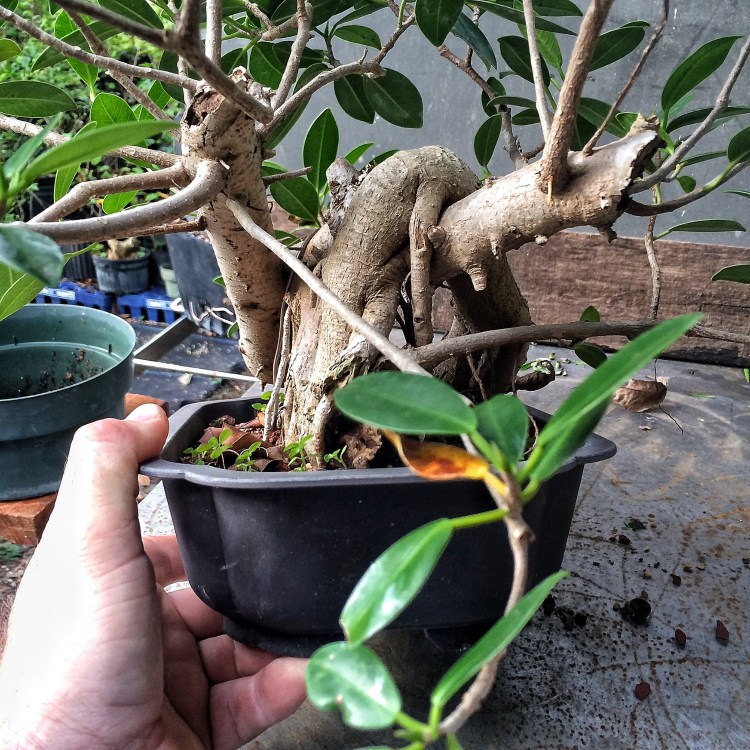 We are spinning around counter-clockwise (or, if you are European-ly-abled, anti-clockwise)
We are spinning around counter-clockwise (or, if you are European-ly-abled, anti-clockwise)
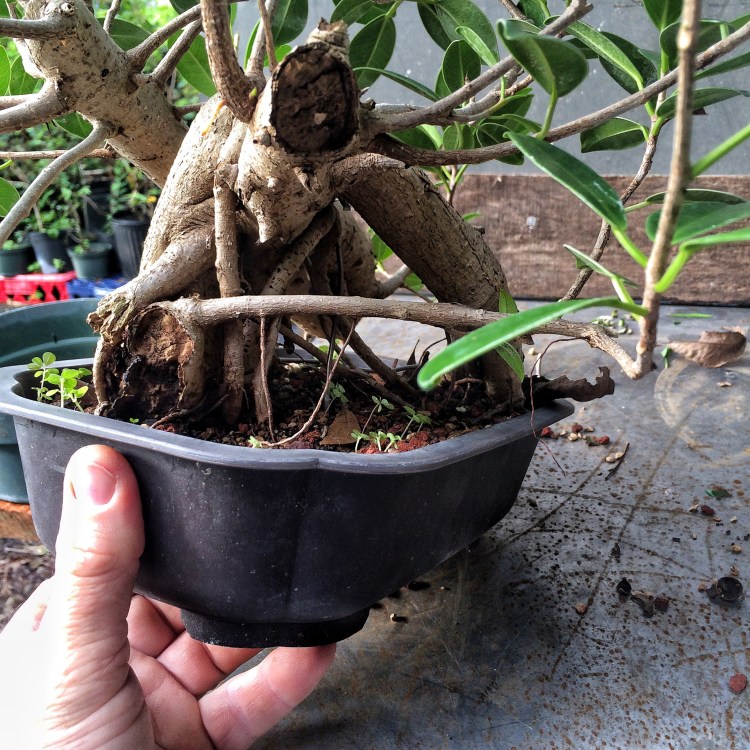

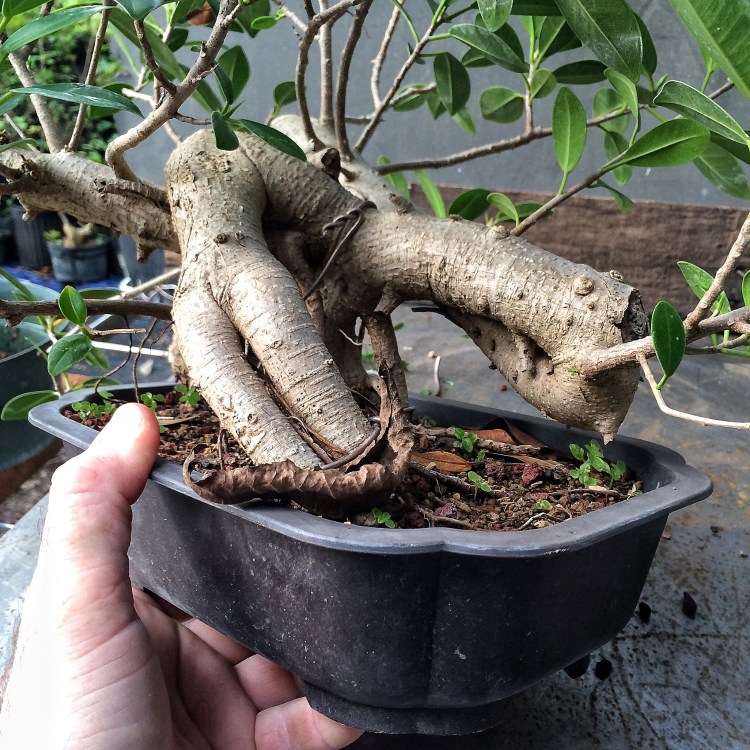 Coming back towards the “front” again.
Coming back towards the “front” again.
Looking down and slightly behind that straight, folded “front” branch.

The fold is beginning to fuse.

I’m not sure how it got folded on itself. I’m just glad it did. Cookie cutter trees are good practice and and all (as I call them, studies) and the Pharisees seem to prefer them over the more interesting trunks (kinda the way that the Salon de Paris of 1863 preferred the more traditional paintings over the Impressionist’s offerings) but give me a challenge any day, I say.
I got it from Mike Cartrett, of Palm Beach Bonsai several years ago.  Ok, it’s a chunk of a trunk, or appears to be from this angle (and bonsai is about appearances, illusions, more than actualities) but now that you’ve seen the tree on all sides, you know it’s more like a hulking animal than a tree. There is also the problem of the straight part after the fold. It’s a tricky tree (I’m sorry, you just have to click on This Video, trust me) to figure out. Here’s a tip: if you can, take it out of the pot……..
Ok, it’s a chunk of a trunk, or appears to be from this angle (and bonsai is about appearances, illusions, more than actualities) but now that you’ve seen the tree on all sides, you know it’s more like a hulking animal than a tree. There is also the problem of the straight part after the fold. It’s a tricky tree (I’m sorry, you just have to click on This Video, trust me) to figure out. Here’s a tip: if you can, take it out of the pot……..

 ……….. it allows you to see the tree without the artificial confines and “framing” that a pot imposes. It opens the eyes to what could be. It releases your imagination! Kinda like peyote. But without the vomiting and then the toxic farts.
……….. it allows you to see the tree without the artificial confines and “framing” that a pot imposes. It opens the eyes to what could be. It releases your imagination! Kinda like peyote. But without the vomiting and then the toxic farts.
Hmmmmmnnnnnn…….I think I know what to do.
 Yes, that’s very interesting…..wait, what’s that sitting conveniently to my left?
Yes, that’s very interesting…..wait, what’s that sitting conveniently to my left?
 Why, it’s a pot! A crescent pot! Will it fit?
Why, it’s a pot! A crescent pot! Will it fit?
 Yes! It will! It’ll take a little finagling but it’ll hold. The pot is by the talented Mrs. Martha J. Goff, of the Tropical Bonsai Greensheets book series fame (available on her website Tropicalgreenbonsai.com)
Yes! It will! It’ll take a little finagling but it’ll hold. The pot is by the talented Mrs. Martha J. Goff, of the Tropical Bonsai Greensheets book series fame (available on her website Tropicalgreenbonsai.com)
Not sure what the J stands for, but I’m almost sure it’s not James. Besides being an author, an inspired potter, a kusamona expert (she gives classes/demos) she also has an excellent line of organic fertilizers.
We now have a good starting point. Time to whittle down the branches and sculpt.
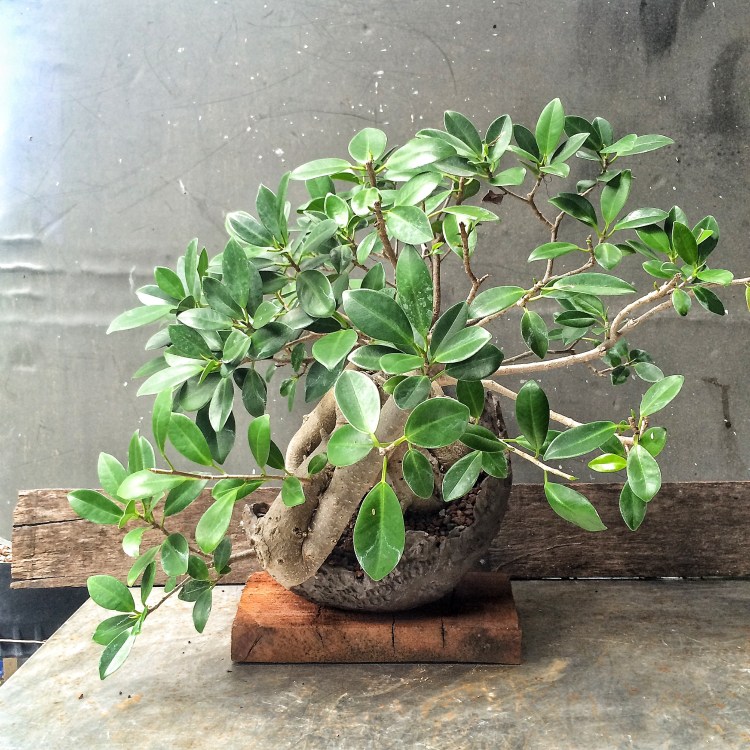 With it being Thanksgiving (here in the USA that means it’s the last Thursday in November) it’s an iffy thing working a ficus this hard (even in sunny Florida). I don’t recommend it. And with that said, let’s get to the butchery…..umm, the pruning and wiring.
With it being Thanksgiving (here in the USA that means it’s the last Thursday in November) it’s an iffy thing working a ficus this hard (even in sunny Florida). I don’t recommend it. And with that said, let’s get to the butchery…..umm, the pruning and wiring.

 One concession to the coming winter I will make, will be to preserve the growth tips on the branches I keep (meaning I’m not pruning the tips). I’m glad I have enough branches to use.
One concession to the coming winter I will make, will be to preserve the growth tips on the branches I keep (meaning I’m not pruning the tips). I’m glad I have enough branches to use.
 I just need to figure out the top….and the back.
I just need to figure out the top….and the back.
 I think that’s enough pruning, now for some wire. It’s the wire that’ll really make it. Ready?
I think that’s enough pruning, now for some wire. It’s the wire that’ll really make it. Ready?
Birds eye view.
Left side
 This side looks like a turkey, right?
This side looks like a turkey, right?
For all those who don’t “agree” with the straight piece in front, I’ve hidden it with this branch, for your protection.
 I need the height and all that the height gives to the design. And I’m really not working with standard material her. And you know what, I kinda like it.
I need the height and all that the height gives to the design. And I’m really not working with standard material her. And you know what, I kinda like it.
And that’s all that really matters. And if those Pharisees don’t like it, then it seems like a good candidate for the Salon De Refusés, right?

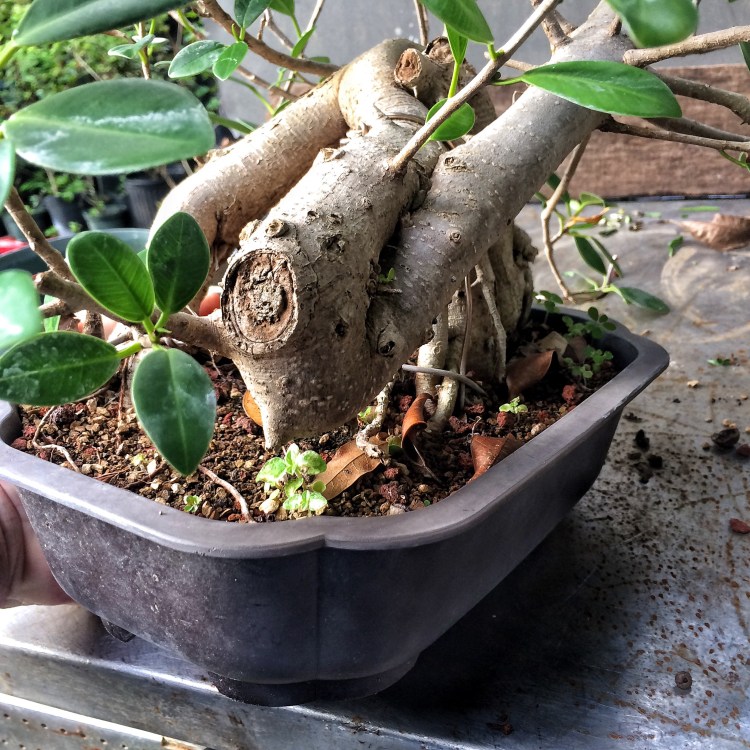








“It’s tricky” Try reading the blog-post whilst the song is playing. Good job on the turkey!
LikeLike
Great work Adam. Love Martha’s pot on this one too!
LikeLike
Love the end result. Looking forward to seeing it develop.
LikeLike
Geniale l’idea di inclinare la base della pianta, facendo così hai rotto la pesantezza del groviglio di rami iniziale in orizzontale, bene ora la pianta ha un suo movimento! Mi piacciono i rami che puntano in opposto al tronco,il tutto viene impreziosito dalla mezza pentola che accentua l’idea di instabilità totale della pianta. Grande Adam.💀💪🏾💀💪🏾💀
LikeLike